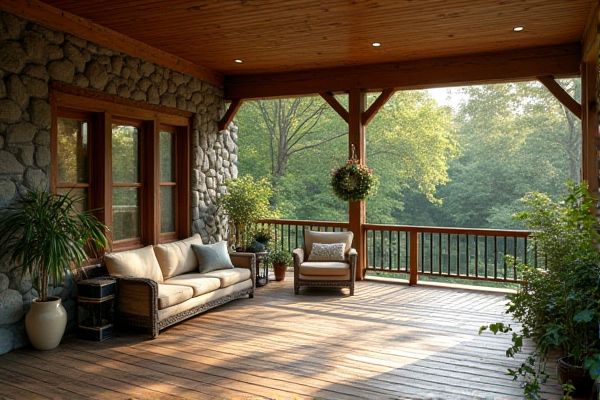
A dry porch is an enclosed or covered outdoor area that remains protected from rain and moisture, offering a comfortable space for relaxation regardless of weather conditions, whereas a wet porch is typically an open or partially covered area that is exposed to the elements, making it susceptible to getting wet during rain. Discover more about how to choose the best porch type for your home by reading the full article.
Table of Comparison
| Feature | Dry Porch | Wet Porch |
|---|---|---|
| Purpose | Provides sheltered outdoor space without direct exposure to rain | Designed for areas exposed to rain, often includes drainage |
| Flooring | Uses materials like wood or carpet, sensitive to moisture | Uses waterproof materials like tile, concrete, or stone |
| Protection | Fully covered, protects against rain and snow | Can be partially open, allows water exposure |
| Maintenance | Lower maintenance, less moisture damage | Higher maintenance due to water exposure and drainage needs |
| Usage | Ideal for seating and storing moisture-sensitive items | Suitable for entryways, mudrooms, or areas prone to wet conditions |
| Construction | Enclosed or screened to keep dry environment | Open design with emphasis on water runoff management |
Introduction to Dry Porch vs Wet Porch
A dry porch is a screened or enclosed area designed to protect you from rain, wind, and insects while allowing fresh air to circulate, making it ideal for outdoor relaxation without exposure to moisture. In contrast, a wet porch is an open or semi-enclosed space often exposed to rain and other elements, typically featuring water-resistant flooring and drainage to handle wet conditions. Understanding these differences helps you decide the best porch type for your home's climate and lifestyle needs.
What Is a Dry Porch?
A dry porch is an enclosed or semi-enclosed outdoor space designed to remain free from moisture, providing protection from rain, snow, and humidity while allowing ventilation and natural light. Unlike a wet porch, which often serves as a transitional area exposed to weather elements or used for activities involving water, a dry porch is typically sealed or screened to maintain a comfortable, weatherproof environment. Common features include durable flooring, weather-resistant materials, and screen or glass panels that prevent water intrusion, making it ideal for year-round use and furniture protection.
What Is a Wet Porch?
A wet porch is an exterior covered area designed with a solid floor and drainage system to handle exposure to rain and moisture, making it suitable for outdoor activities even in wet conditions. Unlike a dry porch, it is built to prevent water accumulation by using materials such as concrete, stone, or treated wood that resist water damage. Wet porches often feature open or screened sides to allow airflow while protecting the main living areas from direct exposure to the elements.
Key Differences Between Dry and Wet Porches
Dry porches are typically enclosed spaces offering protection from rain and wind, making them ideal for year-round use and furniture that requires shelter from moisture. Wet porches are open or semi-enclosed areas exposed to the elements, designed primarily for easy drainage and outdoor living with durable, water-resistant materials. Understanding these distinctions helps you choose the best porch type suited to your climate and lifestyle needs.
Pros and Cons of Dry Porches
Dry porches offer protection from rain and wind, allowing you to enjoy outdoor space year-round without exposure to moisture, which helps in maintaining furniture and flooring. They provide better insulation and can increase your home's energy efficiency but may require more construction costs compared to wet porches. Your choice depends on whether you prefer a fully enclosed area with climate control or an open, airy space for plants and ventilation.
Pros and Cons of Wet Porches
Wet porches provide a functional space for outdoor activities involving water, such as gardening or washing pets, and enhance home ventilation by preventing moisture buildup inside. However, they require regular maintenance to avoid mold, mildew, and water damage due to constant exposure to moisture. Despite these challenges, wet porches offer practical benefits for households needing a durable, water-resistant outdoor area.
Climate Considerations for Porch Selection
Selecting between a dry porch and a wet porch depends heavily on climate factors, as dry porches offer year-round protection in colder, snowy regions by providing an enclosed space free from moisture. Wet porches suit warmer, humid climates where open-air designs allow for ventilation and quick drying after rain, helping to prevent mold and rot. Homeowners in areas with frequent precipitation should prioritize proper drainage and moisture-resistant materials regardless of porch type to enhance durability and comfort.
Maintenance Requirements: Dry vs Wet Porches
Dry porches require less maintenance as they are protected from direct exposure to rain and moisture, reducing the risk of mold, wood rot, and frequent cleaning. Wet porches endure constant exposure to weather elements, necessitating regular sealing, waterproofing, and inspections to prevent water damage and decay. Choosing a dry porch significantly lowers long-term upkeep costs and preserves structural integrity better than wet porch designs.
Cost Comparison: Dry vs Wet Porch Installations
Dry porch installations typically cost less than wet porches due to simpler construction requirements, as they do not need plumbing or intricate waterproofing. Wet porches involve expenses for water-resistant materials, drainage systems, and labor associated with plumbing installation, increasing the overall budget. Your choice between dry and wet porches will significantly impact initial costs and long-term maintenance expenses.
Choosing the Right Porch for Your Home
A dry porch, typically enclosed and protected from direct exposure to rain, provides a versatile space suitable for year-round use and furniture that requires shelter from moisture. A wet porch, often uncovered or partially covered, naturally collects water and is ideal for plants or outdoor activities that embrace weather exposure but requires weather-resistant materials. Selecting between a dry or wet porch depends on climate, intended use, and maintenance preferences, ensuring the porch complements the home's architecture and lifestyle needs.
 homyna.com
homyna.com